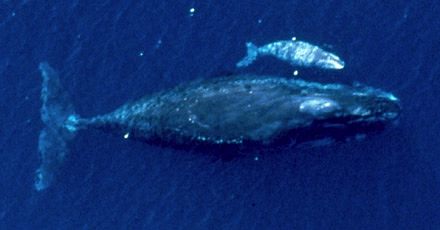 A University of Washington researcher listened to the audio picked up by a recording device that spent a year in the icy waters off the east coast of Greenland. She was stunned at what she heard: whales singing nearly constantly for five months using the most remarkable variety of songs.
A University of Washington researcher listened to the audio picked up by a recording device that spent a year in the icy waters off the east coast of Greenland. She was stunned at what she heard: whales singing nearly constantly for five months using the most remarkable variety of songs.
In 2008, oceanographer Kate Stafford set out to discover how many endangered bowhead whales populated the area. The species was hunted to near-extinction in the 1800’s.
Stafford and her colleagues put two underwater microphones on moorings attached to the seafloor in Fram Strait, an inhospitable, ice-covered stretch of sea between Greenland and the northern islands of Norway. They left them there for as long as the batteries would last: nearly a year. (Photo, Sue Moore listens for bowhead whales – NOAA)
“We hoped to record a few little grunts and moans,” Stafford said. “We were not expecting to get five months of straight singing.”
Not only did they record singing nearly every hour of the day and night, they picked up more than 60 unique songs. The findings also hint at the possibility of a rebound in bowhead whales.
A paper detailing their discoveries appeared July 31 in Endangered Species Research.
The variety of tunes was so surprising that the researchers compared the whales’ song catalog to that of birds.
“Whether individual singers display one, multiple or even all call types, the size of the song repertoire for… bowheads in 2008-2009 is remarkable and more closely approaches that of songbirds than other… whales,” they wrote in the report.
Bowhead whale song is unique in that the whales appear to sing with “two voices,” simultaneously producing high- and low-frequency sounds. The whales sometimes repeat the same tune for hours at a time.
Scientists have yet to learn why the whales sang so consistently that year.
 They believe that bowhead whale song comes from males during mating season. In most other kinds of whales, individuals either sing the same song their whole lives or all members of a population sing the season’s same popular tune. If bowheads are like the former, that would mean more than 60 males were in the Fram Strait. If the population is evenly split between males and females, there could have been more than 100 whales — far more than anyone thought comprised this population.
They believe that bowhead whale song comes from males during mating season. In most other kinds of whales, individuals either sing the same song their whole lives or all members of a population sing the season’s same popular tune. If bowheads are like the former, that would mean more than 60 males were in the Fram Strait. If the population is evenly split between males and females, there could have been more than 100 whales — far more than anyone thought comprised this population.
With further study, the scientists instead could discover that individual bowhead whales have a repertoire of songs that they sing during a season. That would be equally interesting because it would make the bowheads the only known whales to sing a variety of songs in the same season.
“If this is a breeding ground, it would be spectacular,” said Stafford. “For such a critically endangered species, it’s really important to know that there’s a reproductively active portion of the population.”
In addition, since the whales are difficult to study given their year-round residence in the Arctic, virtually nothing was known about where they spend their winters. The research offers a clue about the whales’ migration path.
 Only a handful of bowhead whale populations remain. The largest historic population, which includes the individuals studied for this report, once possibly numbered more than 30,000 members but was hunted to near-extinction from the 1600s through the 1800s. Commercial whaling reduced bowhead whale populations in other regions as well. Combined, the four remaining populations are thought to number fewer than 10,000 members.
Only a handful of bowhead whale populations remain. The largest historic population, which includes the individuals studied for this report, once possibly numbered more than 30,000 members but was hunted to near-extinction from the 1600s through the 1800s. Commercial whaling reduced bowhead whale populations in other regions as well. Combined, the four remaining populations are thought to number fewer than 10,000 members.
Bowhead whales are massive creatures. They grow to over 60 feet long, may live to 200 years old and can weigh 200,000 pounds. They use their huge skulls to break through ice as thick as 1.5 feet.
(Read the full story at Newswise.com)



















